An AIoT Architecture for Structural Testing: Application to a Real Aerospace Component (Embraer E2 Model Aircraft Flag Track)
Abstract
1. Introduction
- Present a generic AIoT architecture for implementing structural testing in aeronautical applications. This architecture allows the integration of wired and wireless IoT devices with different AI algorithms for data processing.
- Promote the integration of different AI-based algorithms for analyzing structural testing results both in run-time and off-line.
- Present a methodology to deploy the AIoT architecture in structural testing applications, with guidelines that may help developers.
- Validate the presented approach experimentally in the certification test of a real aerospace component by analyzing test data obtained by means of IoT devices in real-time.
2. Related Work
| Subject | References |
|---|---|
| AIoT concepts in Industry 4.0 | [1,13,14,15,16,17,18] |
| Architectures for AIoT | [19,20,21,22,23,24] |
| IoT in aeronautics | [6,18,25,26,27,28] |
| IoT for Structural Health Monitoring | [12,29,30,31,32,33] |
| Algorithms for Structural Health Monitoring | [34,35,36,37,38] |
| Real applications | [39,40,41] |
3. AIoT Architecture for Structural Testing
3.1. Overall Architecture
3.2. Implementation Methodology
- Capture of requirements. Definition of mechanical load parameters, monitoring variables, measurement accuracy, sampling frequency, and test duration.
- Design of the AIoT acquisition system. Specification of sensors, actuators, IoT platform, communication QoS, power supply, and system calibration and tuning.
- Real-time analysis of test data. Implementation of appropriate AI techniques for data preprocessing, model training, validation, and real-time prediction.
- Leverage the results of the real-time analysis. Execution of test alerts, automated shutdowns, data storage for client access, and offline result interpretation.
- Delivery of final test results. Provision of test data, applied procedures, test history, and compliance certificates.
4. Case Study: Embraer E2 Model Aircraft Flag Track
4.1. Implementation Following the Methodology
4.2. Detail of the Implemented Services
5. Results and Discussion
5.1. Preparatory Works
5.2. Description of the Structural Test
5.3. Discussion of Results
5.3.1. Measurement Accuracy
5.3.2. Efficient AI Integration
5.3.3. Operational Features
5.3.4. Advanced Flexible Services
5.3.5. Data Transfer Security
6. Conclusions
Author Contributions
Funding
Institutional Review Board Statement
Informed Consent Statement
Data Availability Statement
Conflicts of Interest
Abbreviations
| IoT | Internet of Things |
| IIoT | Industrial Internet of Things |
| AI | Artificial Intelligence |
| AIoT | Artificial Intelligence of Things |
| WSN | Wireless Sensor Network |
| ASTM | American Society for Testing and Materials |
| OEM | Original Equipment Manufacturer |
| DOA | Design Organization Approval |
| EASA | European Union Aviation Safety Agency |
| FAA | Federal Aviation Administration |
| CAAC | Civil Aviation Administration of China |
| FEM | Finite Element Method |
| ML | Machine Learning |
| LSVCA | Load Sensing Valve-Controlled Actuator |
| SHM | Structural Health Monitoring |
| XAI | eXplainable Artificial Intelligence |
| IML | Interpretable Machine Learning |
| MQTT | Message Queue Telemetry Transport |
| QoS | Quality of Service |
| SMB | Server Message Block |
| RPi | Raspberry Pi |
| GUI | Graphical User Interface |
| SSL | Secure Sockets Layer |
| ARIMA | Auto Regressive Integrated Moving Average |
| LSTM | Long Short-Term Memory |
| MSE | Mean Squared Error |
References
- Matin, A.; Islam, M.R.; Wang, X.; Huo, H.; Xu, G. AIoT for sustainable manufacturing: Overview, challenges, and opportunities. Internet Things 2023, 24, 100901. [Google Scholar] [CrossRef]
- Syafrudin, M.; Alfian, G.; Fitriyani, N.L.; Rhee, J. Performance analysis of IoT-based sensor, big data processing, and machine learning model for real-time monitoring system in automotive manufacturing. Sensors 2018, 18, 2946. [Google Scholar] [CrossRef]
- Chiang, M.; Zhang, T. Fog and IoT: An Overview of Research Opportunities. IEEE Internet Things J. 2016, 3, 854–864. [Google Scholar] [CrossRef]
- Noura, M.; Atiquzzaman, M.; Gaedke, M. Interoperability in Internet of Things: Taxonomies and Open Challenges. Mob. Netw. Appl. 2019, 24, 796–809. [Google Scholar] [CrossRef]
- Guyon, I.; Amine, R.; Tamayo, S.; Fontane, F. Analysis of the opportunities of industry 4.0 in the aeronautical sector. In Proceedings of the 10th International Multi-Conference on Complexity, Informatics and Cybernetics, IMCIC 2019, Orlando, FL, USA, 12–15 March 2019; Volume 2, pp. 62–67. [Google Scholar]
- Zutin, G.C.; Barbosa, G.F.; de Barros, P.C.; Tiburtino, E.B.; Kawano, F.L.F.; Shiki, S.B. Readiness levels of Industry 4.0 technologies applied to aircraft manufacturing—A review, challenges and trends. Int. J. Adv. Manuf. Technol. 2022, 120, 927–943. [Google Scholar] [CrossRef]
- Leong, K.W.; Clark, P.J. Hazards and Mitigation Measures in Aerospace Non-Destructive Testing. Int. J. Aviat. Aeronaut. Aerosp. 2018, 5, 5. [Google Scholar] [CrossRef]
- Ravikovich, Y.; Kholobtsev, D.; Arkhipov, A.; Popov, G. Estimation of fatigue margins for composite parts of aircraft engine on the base of vibration tests. Proc. IOP Conf. Ser. Mater. Sci. Eng. 2020, 868, 012027. [Google Scholar] [CrossRef]
- Kim, H.g.; Kim, S.; Hong, S.h.; Choi, H.k.; Kim, S.h. Structural static test for validation of the structural integrity of an aircraft pylon. Aerosp. Sci. Technol. 2022, 122, 107402. [Google Scholar] [CrossRef]
- Artetxe, E.; Barambones, O.; Calvo, I.; Fernández-Bustamante, P.; Martin, I.; Uralde, J. Wireless Technologies for Industry 4.0 Applications. Energies 2023, 16, 1349. [Google Scholar] [CrossRef]
- Abdelgawad, A.; Yelamarthi, K. Internet of things (IoT) platform for structure health monitoring. Wirel. Commun. Mob. Comput. 2017, 2017, 1349. [Google Scholar] [CrossRef]
- Rahita, A.C.; Zaki, A.; Nugroho, G.; Yadi, S. Internet of Things (IoT) in Structural Health Monitoring: A Decade of Research Trends. Instrum. Mes. Metrol. 2024, 23, 123–139. [Google Scholar] [CrossRef]
- Younan, M.; Houssein, E.H.; Elhoseny, M.; Ali, A.A. Challenges and recommended technologies for the industrial internet of things: A comprehensive review. Meas. J. Int. Meas. Confed. 2020, 151, 107198. [Google Scholar] [CrossRef]
- Chalapathi, G.S.S.; Chamola, V.; Vaish, A.; Buyya, R. Industrial Internet of Things (IIoT) applications of edge and fog computing: A review and future directions. In Fog/Edge Computing for Security, Privacy, and Applications; Springer: Cham, Switzerland, 2021; pp. 293–325. [Google Scholar]
- Khan, W.Z.; Rehman, M.; Zangoti, H.M.; Afzal, M.K.; Armi, N.; Salah, K. Industrial internet of things: Recent advances, enabling technologies and open challenges. Comput. Electr. Eng. 2020, 81, 106522. [Google Scholar] [CrossRef]
- Devan, P.A.M.; Hussin, F.A.; Ibrahim, R.; Bingi, K.; Khanday, F.A. A Survey on the application of WirelessHART for industrial process monitoring and control. Sensors 2021, 21, 4951. [Google Scholar] [CrossRef]
- Liu, Y.; Kashef, M.; Lee, K.B.; Benmohamed, L.; Candell, R. Wireless network design for emerging IIoT applications: Reference framework and use cases. Proc. IEEE 2019, 107, 1166–1192. [Google Scholar] [CrossRef]
- Rodrigues, D.; Carvalho, P.; Lima, S.R.; Lima, E.; Lopes, N.V. An IoT platform for production monitoring in the aerospace manufacturing industry. J. Clean. Prod. 2022, 368, 133264. [Google Scholar] [CrossRef]
- Pivoto, D.G.; de Almeida, L.F.; da Rosa Righi, R.; Rodrigues, J.J.; Lugli, A.B.; Alberti, A.M. Cyber-physical systems architectures for industrial internet of things applications in Industry 4.0: A literature review. J. Manuf. Syst. 2021, 58, 176–192. [Google Scholar] [CrossRef]
- Teoh, Y.K.; Gill, S.S.; Parlikad, A.K. IoT and Fog-Computing-Based Predictive Maintenance Model for Effective Asset Management in Industry 4.0 Using Machine Learning. IEEE Internet Things J. 2023, 10, 2087–2094. [Google Scholar] [CrossRef]
- Ayvaz, S.; Alpay, K. Predictive maintenance system for production lines in manufacturing: A machine learning approach using IoT data in real-time. Expert Syst. Appl. 2021, 173, 114598. [Google Scholar] [CrossRef]
- Omoniwa, B.; Hussain, R.; Javed, M.A.; Bouk, S.H.; Malik, S.A. Fog/edge computing-based IoT (FECIoT): Architecture, applications, and research issues. IEEE Internet Things J. 2019, 6, 4118–4149. [Google Scholar] [CrossRef]
- Nakagawa, E.Y.; Antonino, P.O.; Schnicke, F.; Capilla, R.; Kuhn, T.; Liggesmeyer, P. Industry 4.0 reference architectures: State of the art and future trends. Comput. Ind. Eng. 2021, 156, 107241. [Google Scholar] [CrossRef]
- Villar, E.; Toral, I.M.; Calvo, I.; Barambones, O.; Fernández-Bustamante, P. Architectures for Industrial AIoT Applications. Sensors 2024, 24, 4929. [Google Scholar] [CrossRef] [PubMed]
- Mastandrea, G.; Mattia, D.; D’Oriano, L.; Rana, G.R.; Nocera, F.; Mongiello, M. IOT data-driven experimental process optimisation for kevlar fiberglass components for aeronautic. In Proceedings of the IEEE International Workshop on Metrology for Industry 4.0 and IoT, MetroInd 4.0 and IoT 2021, Rome, Italy, 7–9 June 2021; pp. 18–22. [Google Scholar] [CrossRef]
- Blagojevic, M.; Dieudonne, A.; Kamecki, L.; Kiziroglou, M.E.; Krastev, K.; Marty, D.; Piguet, D.; Spasic, S.; Wright, S.W.; Yeatman, E.M. Autonomous Electrical Current Monitoring System for Aircraft. IEEE Trans. Aerosp. Electron. Syst. 2023, 59, 3345–3358. [Google Scholar] [CrossRef]
- Guerrero Garcia, J.M.; Sasikumar, A.; Llobet Vallejo, J.; Costa i Balanzat, J. Experimental and virtual testing of a composite-aluminium aircraft wingbox under thermal loading. Aerosp. Sci. Technol. 2023, 138, 108329. [Google Scholar] [CrossRef]
- Malik, S.; Rouf, R.; Mazur, K.; Kontsos, A. The Industry Internet of Things (IIoT) as a methodology for autonomous diagnostics in aerospace structural health monitoring. Aerospace 2020, 7, 64. [Google Scholar] [CrossRef]
- Deng, H.; Chen, J. A Survey of Structural Health Monitoring Advances Based on Internet of Things (IoT) Sensors. Int. J. Adv. Comput. Sci. Appl. 2023, 14, 225–234. [Google Scholar] [CrossRef]
- Saravanan, T.J.; Mishra, M.; Aherwar, A.D.; Lourenço, P.B. Internet of things (IoT)-based structural health monitoring of laboratory-scale civil engineering structures. Innov. Infrastruct. Solut. 2024, 9, 110. [Google Scholar] [CrossRef]
- Chen, J.; Reitz, J.; Richstein, R.; Schröder, K.U.; Roßmann, J. IoT-Based SHM Using Digital Twins for Interoperable and Scalable Decentralized Smart Sensing Systems. Information 2024, 15, 121. [Google Scholar] [CrossRef]
- Zonzini, F.; Aguzzi, C.; Gigli, L.; Sciullo, L.; Testoni, N.; De Marchi, L.; Di Felice, M.; Cinotti, T.S.; Mennuti, C.; Marzani, A. Structural Health Monitoring and Prognostic of Industrial Plants and Civil Structures: A Sensor to Cloud Architecture. IEEE Instrum. Meas. Mag. 2020, 23, 21–27. [Google Scholar] [CrossRef]
- Hodgson, M.; Rizzo, P.; Dickerson, S.J. Wireless portable transducer for nondestructive evaluation applications based on highly nonlinear solitary waves. Meas. J. Int. Meas. Confed. 2023, 214, 112760. [Google Scholar] [CrossRef]
- Mukhti, J.A.; Gucunski, N.; Kee, S.H. AI-assisted ultrasonic wave analysis for automated classification of steel corrosion-induced concrete damage. Autom. Constr. 2024, 167, 105704. [Google Scholar] [CrossRef]
- Kumar, P.; Kota, S.R. IoT enabled diagnosis and prognosis framework for structural health monitoring. J. Ambient. Intell. Humaniz. Comput. 2023, 14, 11301–11318. [Google Scholar] [CrossRef]
- Fera, F.T.; Spandonidis, C. An Artificial Intelligence and Industrial Internet of Things-Based Framework for Sustainable Hydropower Plant Operations. Smart Cities 2024, 7, 496–517. [Google Scholar] [CrossRef]
- Gong, Y.; Shao, H.; Luo, J.; Li, Z. A deep transfer learning model for inclusion defect detection of aeronautics composite materials. Compos. Struct. 2020, 252, 112681. [Google Scholar] [CrossRef]
- Outa, R.; Chavarette, F.R.; Mishra, V.N.; Gonçalves, A.C.; Roefero, L.G.; Moro, T.C. Prognosis and fail detection in a dynamic rotor using artificial immunological system. Eng. Comput. 2020, 37, 3127–3145. [Google Scholar] [CrossRef]
- Le, X.; Mei, J.; Zhang, H.; Zhou, B.; Xi, J. A learning-based approach for surface defect detection using small image datasets. Neurocomputing 2020, 408, 112–120. [Google Scholar] [CrossRef]
- Fawad, M.; Salamak, M.; Poprawa, G.; Koris, K.; Jasinski, M.; Lazinski, P.; Piotrowski, D.; Hasnain, M.; Gerges, M. Author Correction: Automation of structural health monitoring (SHM) system of a bridge using BIMification approach and BIM-based finite element model development. Sci. Rep. 2023, 13, 17638. [Google Scholar] [CrossRef]
- Zhao, Z.; Song, W.; Wang, H.; Sun, Y.; Luo, H. Development and Application of IoT Monitoring Systems for Typical Large Amusement Facilities. Sensors 2024, 18, 4433. [Google Scholar] [CrossRef]
- Naik, N. Choice of effective messaging protocols for IoT systems: MQTT, CoAP, AMQP and HTTP. In Proceedings of the 2017 IEEE International Systems Engineering Symposium (ISSE), Vienna, Austria, 11–13 October 2017; pp. 1–7. [Google Scholar]
- Soni, D.; Makwana, A. A survey on mqtt: A protocol of internet of things (iot). In Proceedings of the International Conference on Telecommunication, Power Analysis and Computing Techniques (ICTPACT-2017), Vienna, Austria, 11–13 October 2017; Volume 20, pp. 173–177. [Google Scholar]
- Calvo, I.; Gil-García, J.M.; Villar, E.; Fernández, A.; Velasco, J.; Barambones, O.; Napole, C.; Fernández-Bustamante, P. Design and performance of a xbee 900 Mhz acquisition system aimed at industrial applications. Appl. Sci. 2021, 11, 8174. [Google Scholar] [CrossRef]
- Calvo, I.; Espin, A.; Gil-García, J.M.; Fernández Bustamante, P.; Barambones, O.; Apiñaniz, E. Scalable IoT Architecture for Monitoring IEQ Conditions in Public and Private Buildings. Energies 2022, 15, 2270. [Google Scholar] [CrossRef]
- Toldinas, J.; Lozinskis, B.; Baranauskas, E.; Dobrovolskis, A. MQTT quality of service versus energy consumption. In Proceedings of the 2019 23rd International Conference Electronics, IEEE, Palanga, Lithuania, 17–19 June 2019; pp. 1–4. [Google Scholar]
- Martín Toral, I.; Calvo, I.; Villar, E.; Gil-García, J.; Barambones, O. Introducing Security Mechanisms in OpenFog-Compliant Smart Buildings. Electronics 2024, 13, 2900. [Google Scholar] [CrossRef]
- Sen, J.; Mehtab, S. Long-and-Short-Term Memory (LSTM) NetworksArchitectures and Applications in Stock Price Prediction. In Emerging Computing Paradigms: Principles, Advances and Applications; Wiley: Hoboken, NJ, USA, 2022; pp. 143–160. [Google Scholar]
- Zeng, T.; Li, Y.; Zeng, D.; Zhang, Y.; Weng, Y.; Qiao, J.; Bi, X.; Liu, H. Analysis of Data Quality Impact on Load Forecasting. In Proceedings of the 2024 IEEE 7th Student Conference on Electric Machines and Systems (SCEMS), Macao, China, 6–8 November 2024; pp. 1–5. [Google Scholar]
- Mishra, B.K.; Preniqi, V.; Thakker, D.; Feigl, E. Machine learning and deep learning prediction models for time-series: A comparative analytical study for the use case of the UK short-term electricity price prediction. Discov. Internet Things 2024, 4, 24. [Google Scholar] [CrossRef]
- Lah, M.S.C.; Arbaiy, N.; Lin, P.C. Forecasting of ARIMA air pollution with improved fuzzy data preparation. Proc. AIP Conf. Proc. 2022, 2644, 040006. [Google Scholar]
- Li, Y.; Xu, L.; Qin, W.; Xie, C.; Ji, C. A Traffic Flow Data Quality Repair Model Based on Spatiotemporal Correlation. IEEE Access 2024, 12, 116816–116828. [Google Scholar] [CrossRef]
- Oladapo, B.; Olawumi, M.A.; Omigbodun, F.T. Predictive Models Enhancing Sustainability in Industrial Practices. Sustainability 2024, 16, 10358. [Google Scholar] [CrossRef]
- Verma, S.; Prakash Sahu, S.; Prasad Sahu, T. Ensemble Approach for Stock Market Forecasting Using ARIMA and LSTM Model. In Proceedings of the Third International Conference on Intelligent Computing, Information and Control Systems, Madurai, India, 6–8 May 2021; Springer: Cham, Switzerland, 2022; pp. 65–80. [Google Scholar]
- Cui, J.; Wang, J.; Dong, L. A Novel Prediction Method for the Remaining Life of Corrosion Damage in Oil and Gas Pipeline Systems. IEEE Access 2024, 12, 176104–176123. [Google Scholar] [CrossRef]
- Shafique, M.A.; Lee, J.A. ON-CNN: Low Latency and High Throughput Online Arithmetic based Convolutional Neural Network Accelerator. IEEE Access 2024, 12, 175698–175714. [Google Scholar] [CrossRef]
- Kossi, K.; Coulombe, S.; Desrosiers, C. No-reference video quality assessment using transformers and attention recurrent networks. IEEE Access 2024, 12, 140671–140680. [Google Scholar] [CrossRef]
- Anthraper, J.J.; Kotak, J. Security, privacy and forensic concern of MQTT protocol. In Proceedings of the International Conference on Sustainable Computing in Science, Technology and Management (SUSCOM), Amity University Rajasthan, Jaipur, India, 26–28 February 2019; pp. 876–883. [Google Scholar]
- Park, C.S.; Nam, H.M. Security architecture and protocols for secure MQTT-SN. IEEE Access 2020, 8, 226422–226436. [Google Scholar] [CrossRef]
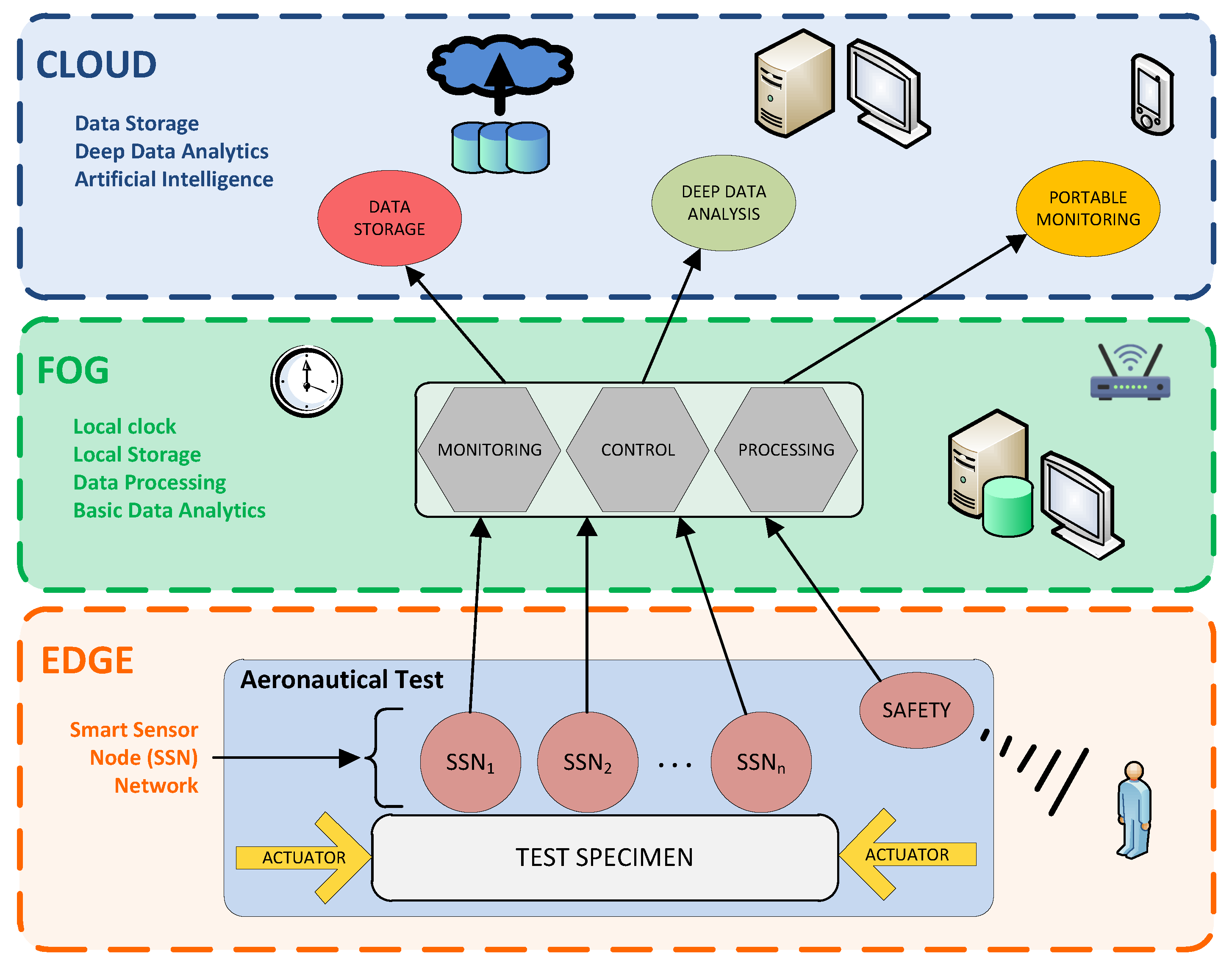
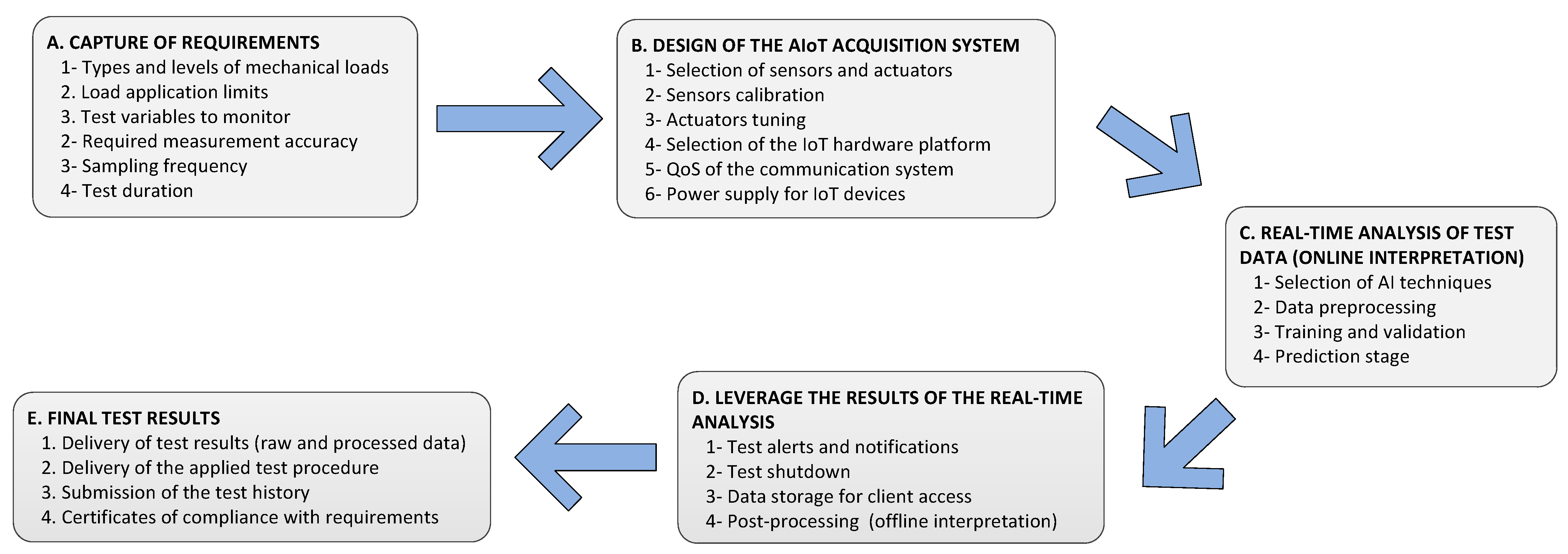

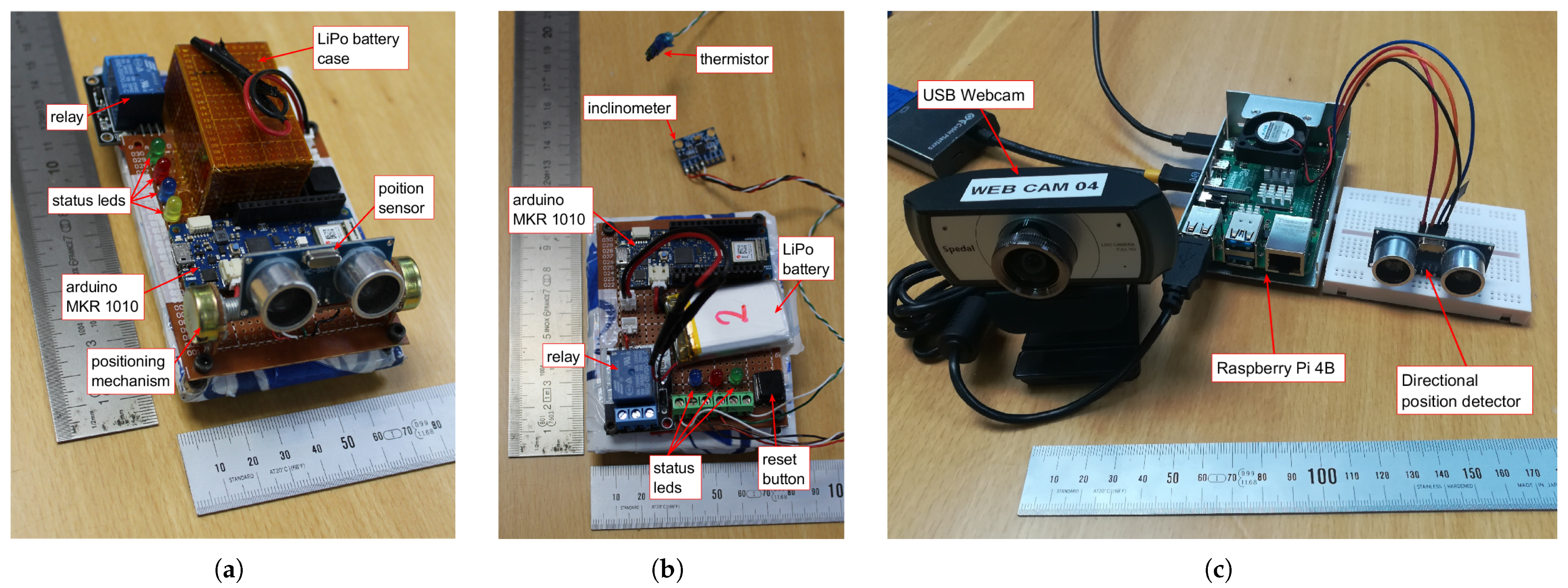
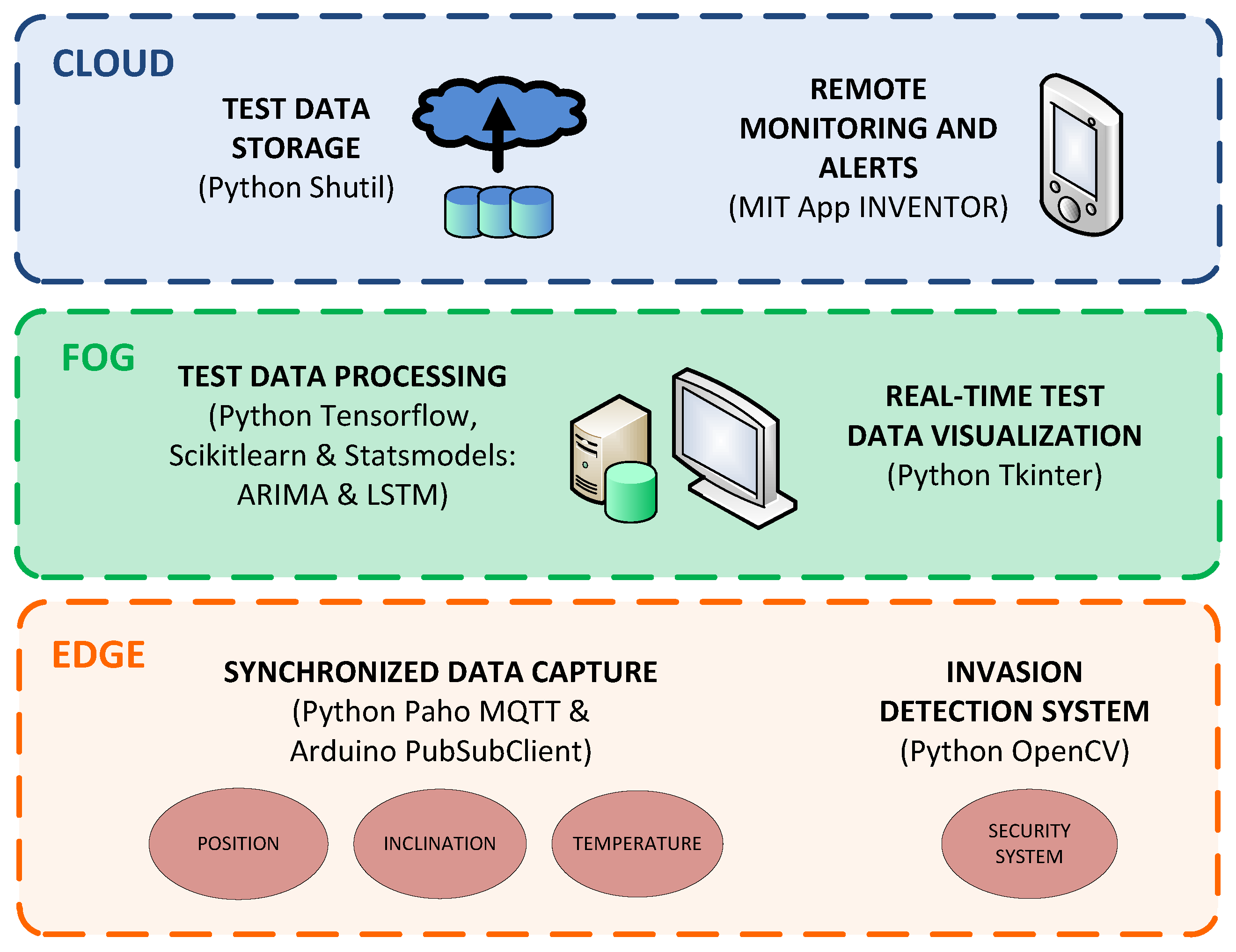
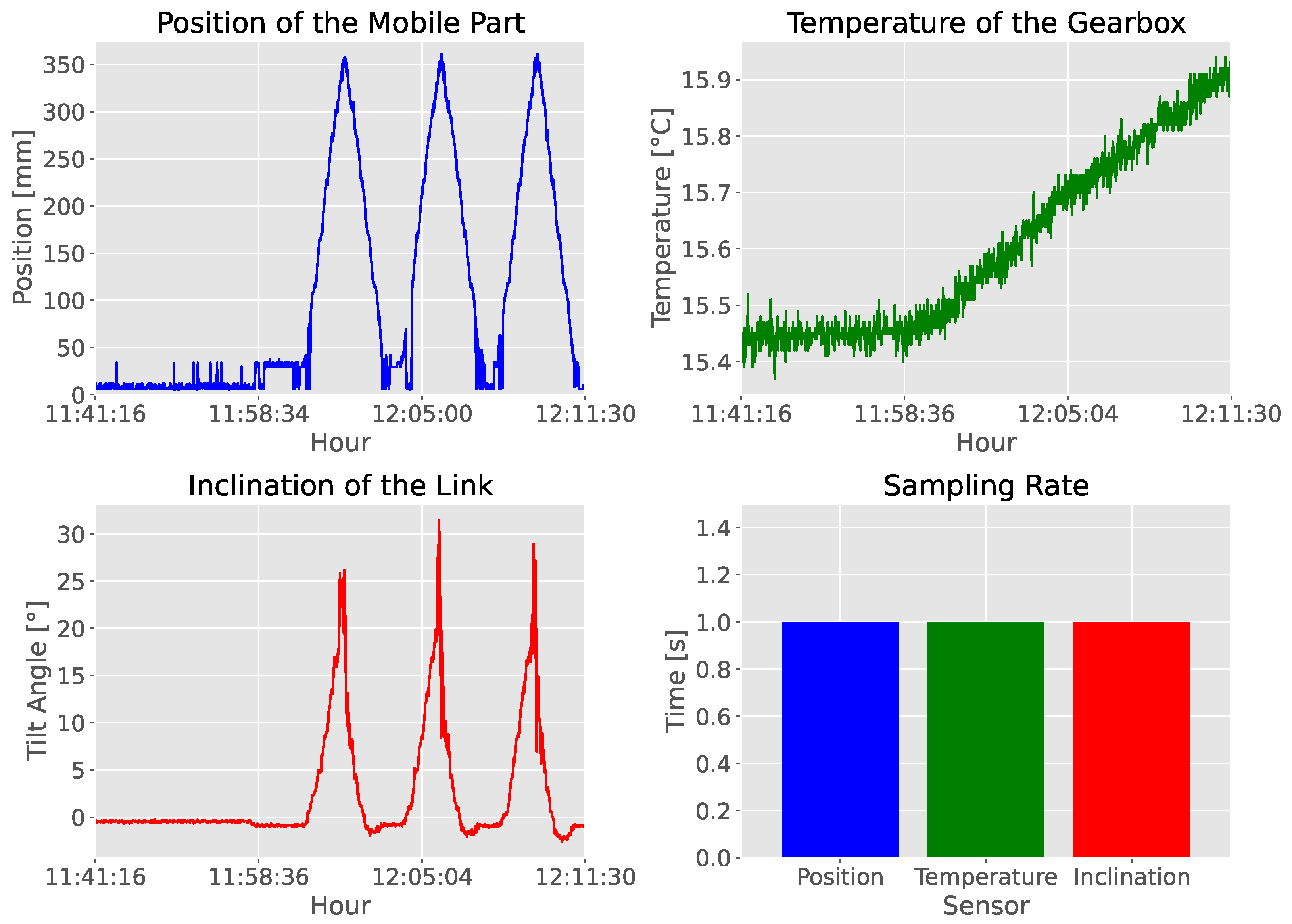
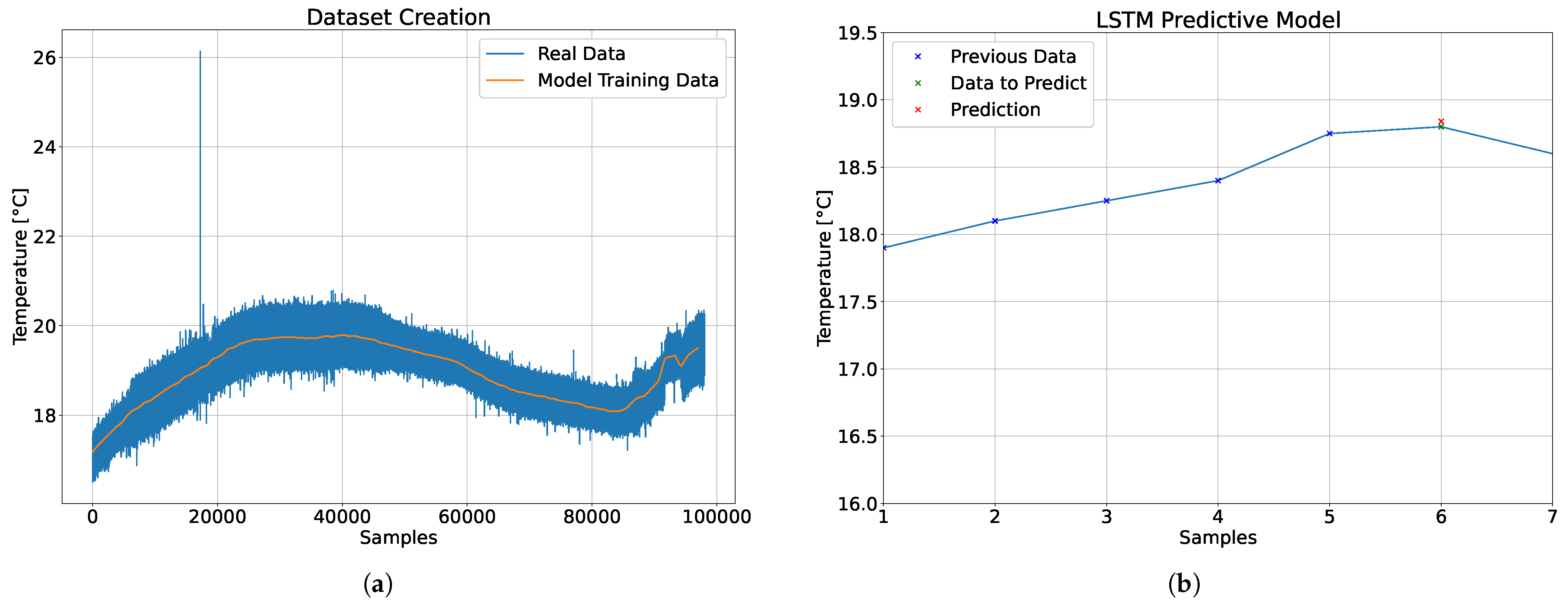


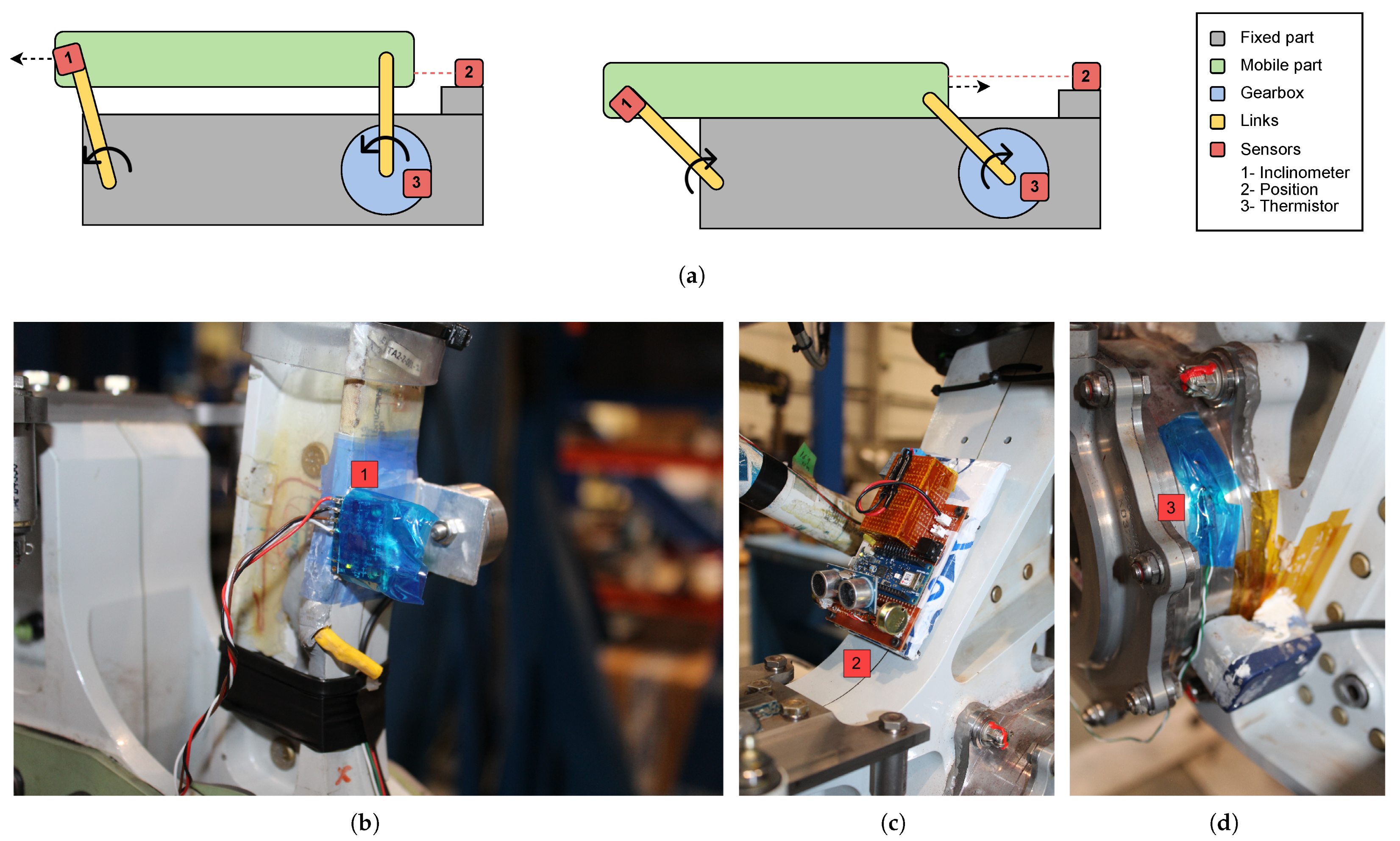
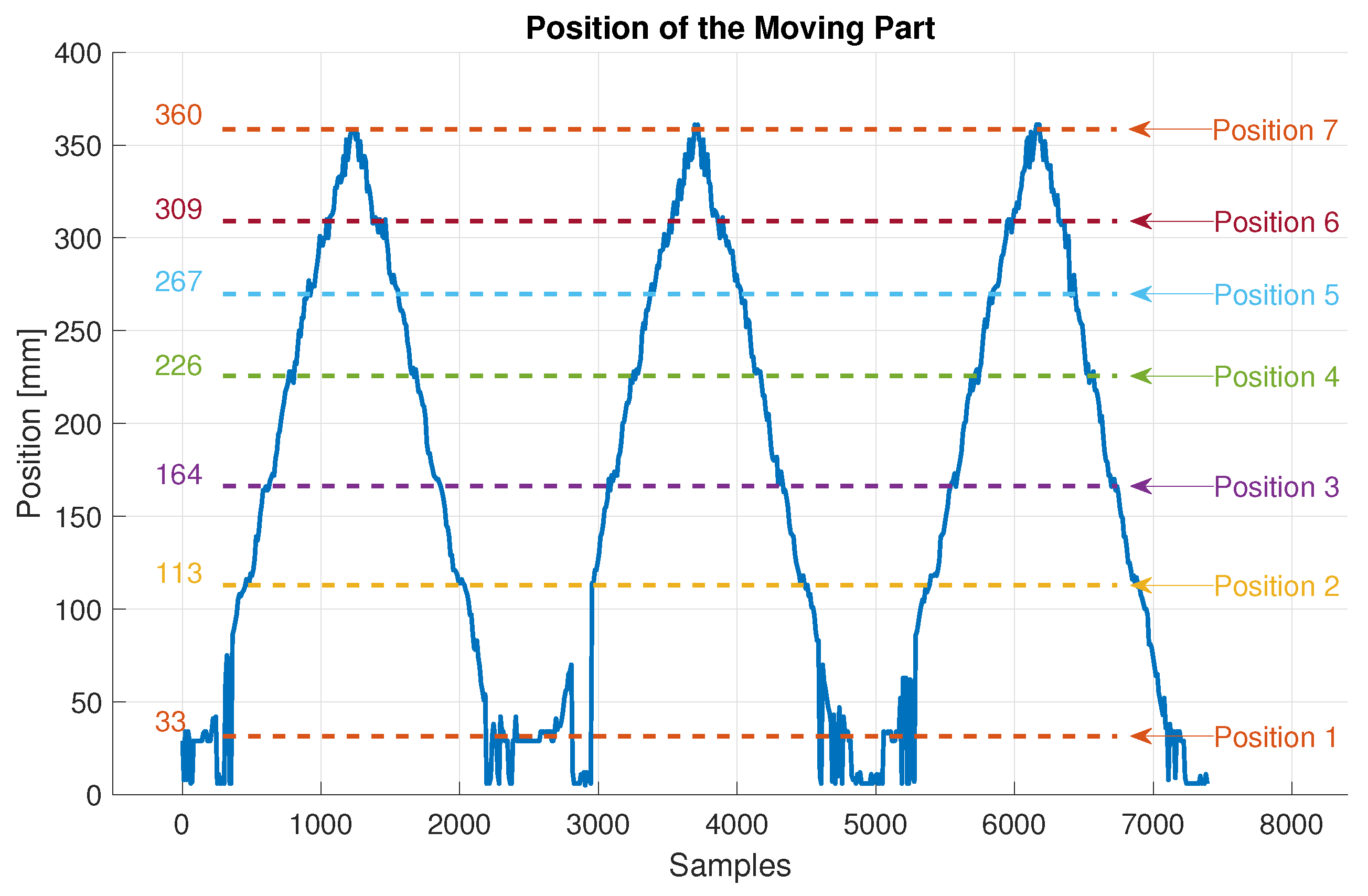

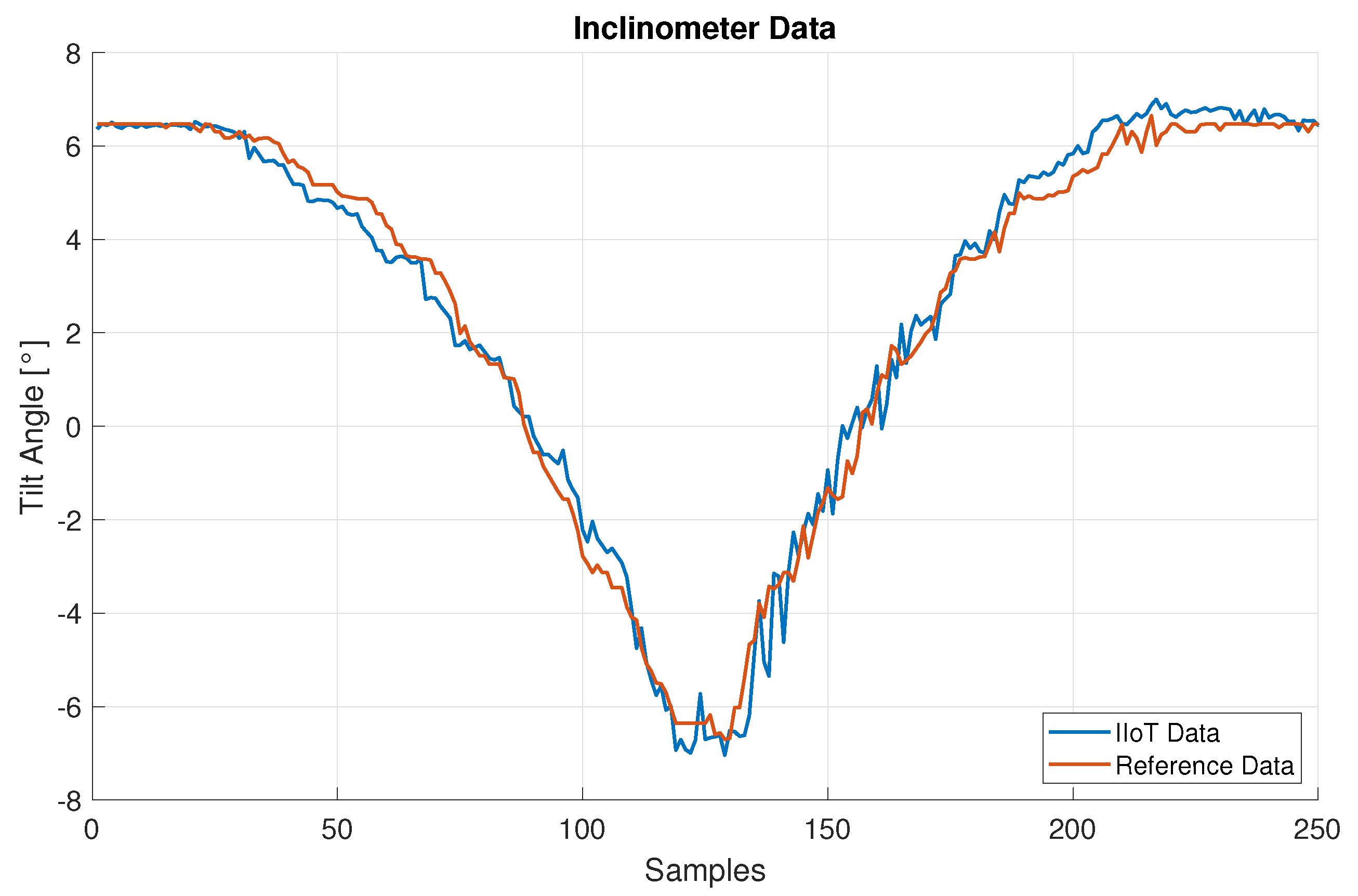
| Category\Test | Low Acquisition Frequency Fatigue Tests (Freq. ≤ 1 Hz) | High Acquisition Frequency Structural Tests (Freq. > 1 Hz) | Other Types of Tests |
|---|---|---|---|
| Measurement capacity | • Accuracy is ensured by the implementation procedure and the calibration process. | • Data transfer technology with higher transfer rate is required (WirelessHart or ZigBee). | • AIoT architecture provides greater data logging capacity through the use of cloud services. |
| • Ultrasonic sensors provide average error of 0.2%. | • No significant limitations due to the size of data in short-duration tests. | • Sensors with technical capabilities adapted to the specific requirements are necessary. | |
| • Average temperature difference of 1.8% (0.05% after filtering). | • Temperature sensor used in the fatigue test is valid for more stringent test (freq. ≤ 1 Hz). | ||
| • Tilt values with an average difference of 1.2%. | • Tilt sensor allows the applicability to other tests with larger rotation angles. | ||
| • Positioning flexibility of the wireless sensors. | • Sensors with higher performance are necessary for dynamic testing. | ||
| AI integration | • AIoT architectures are designed to facilitate the integration and deployment of AI models in each of the layers: edge, fog and cloud. | ||
| • Predictive models have been successfully applied in the fog layer to predict future values and anticipate anomalies in the test. | |||
| • The accuracy achieved through the combination of ARIMA and LSMT models in 5-s predictions resulted in an MSE below 8%, ensuring effective monitoring of the evolution of the test. | |||
| • Cloud layer was used as a backup for raw data history in this study, but more complex ML models can also be applied to analyze large amounts of data. | |||
| Operational features | • Wireless nature simplifies and accelerates the installation process and eliminates the need for connectors and routing cables, minimizing material consumption and removing the cable management complexity. | ||
| • Increased flexibility in sensor positioning facilitates the integration into a wide variety of specimen geometries. | |||
| • Absence of cables eliminates potential wiring errors, reduces preparation and installation time and enhances the scalability of the system. | |||
| • Easy deployment in hard-to-access areas without the constraints of cabling. The reduction in cable weight minimizes its impact on test specimens. | |||
| Advanced services | • Direct connection to the computing center through mobile applications, for requesting information and sending alerts. | ||
| • Connecting new MQTT clients to the AIoT network is quick and easy to perform. | |||
| • Large amount of resources available to apply ML techniques to analyze and leverage the recorded data. | |||
| • Cloud services available to store large amounts of recorded data and apply deep analytics. | |||
| • Remote access to all the information from anywhere and on any device. | |||
| Data security | • No interference from nearby radiofrequency sources, by selecting distant channels within the 2.4 GHz WiFi band. | ||
| • Security of the data transmissions guaranteed by means of SSL protocol. | |||
Disclaimer/Publisher’s Note: The statements, opinions and data contained in all publications are solely those of the individual author(s) and contributor(s) and not of MDPI and/or the editor(s). MDPI and/or the editor(s) disclaim responsibility for any injury to people or property resulting from any ideas, methods, instructions or products referred to in the content. |
© 2025 by the authors. Licensee MDPI, Basel, Switzerland. This article is an open access article distributed under the terms and conditions of the Creative Commons Attribution (CC BY) license (https://creativecommons.org/licenses/by/4.0/).
Share and Cite
Venegas, P.; Virto, U.; Calvo, I.; Barambones, O. An AIoT Architecture for Structural Testing: Application to a Real Aerospace Component (Embraer E2 Model Aircraft Flag Track). Appl. Sci. 2025, 15, 4625. https://doi.org/10.3390/app15094625
Venegas P, Virto U, Calvo I, Barambones O. An AIoT Architecture for Structural Testing: Application to a Real Aerospace Component (Embraer E2 Model Aircraft Flag Track). Applied Sciences. 2025; 15(9):4625. https://doi.org/10.3390/app15094625
Chicago/Turabian StyleVenegas, Pablo, Unai Virto, Isidro Calvo, and Oscar Barambones. 2025. "An AIoT Architecture for Structural Testing: Application to a Real Aerospace Component (Embraer E2 Model Aircraft Flag Track)" Applied Sciences 15, no. 9: 4625. https://doi.org/10.3390/app15094625
APA StyleVenegas, P., Virto, U., Calvo, I., & Barambones, O. (2025). An AIoT Architecture for Structural Testing: Application to a Real Aerospace Component (Embraer E2 Model Aircraft Flag Track). Applied Sciences, 15(9), 4625. https://doi.org/10.3390/app15094625








